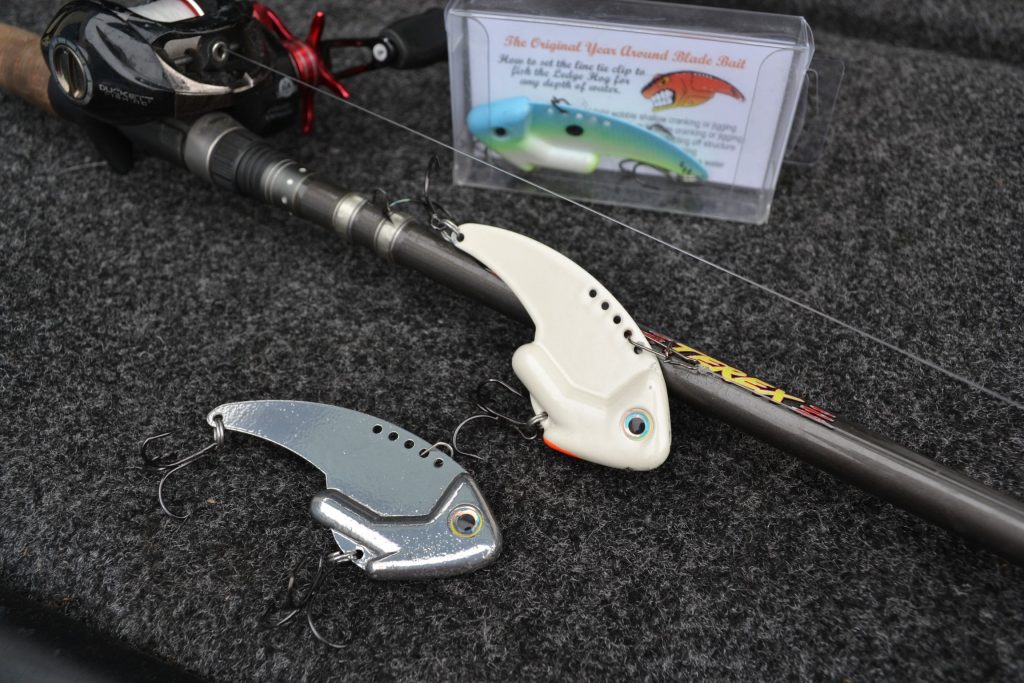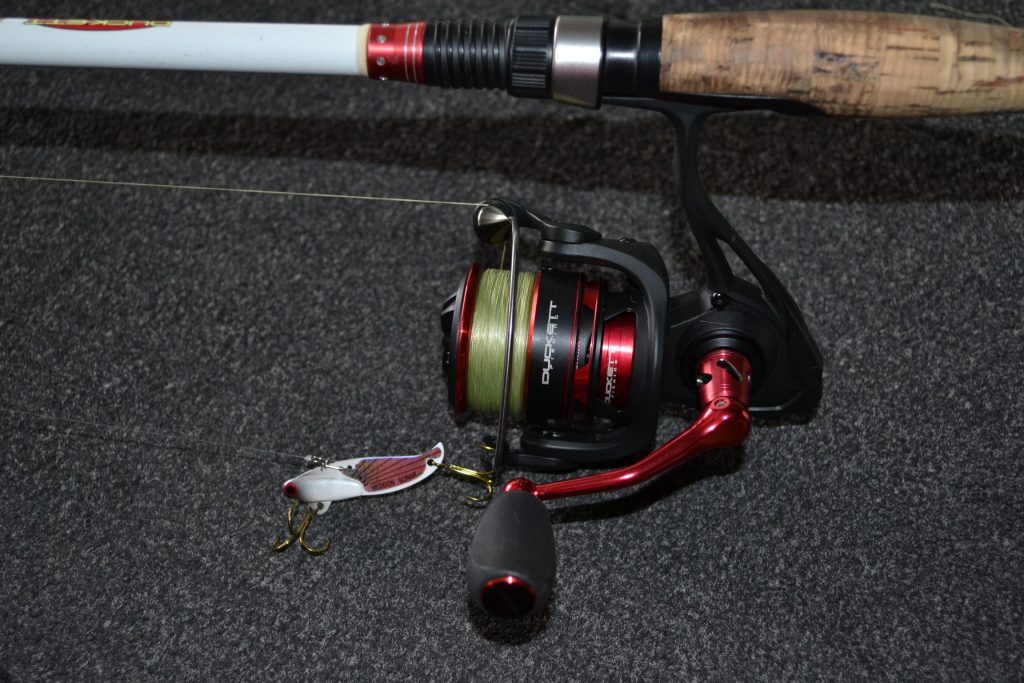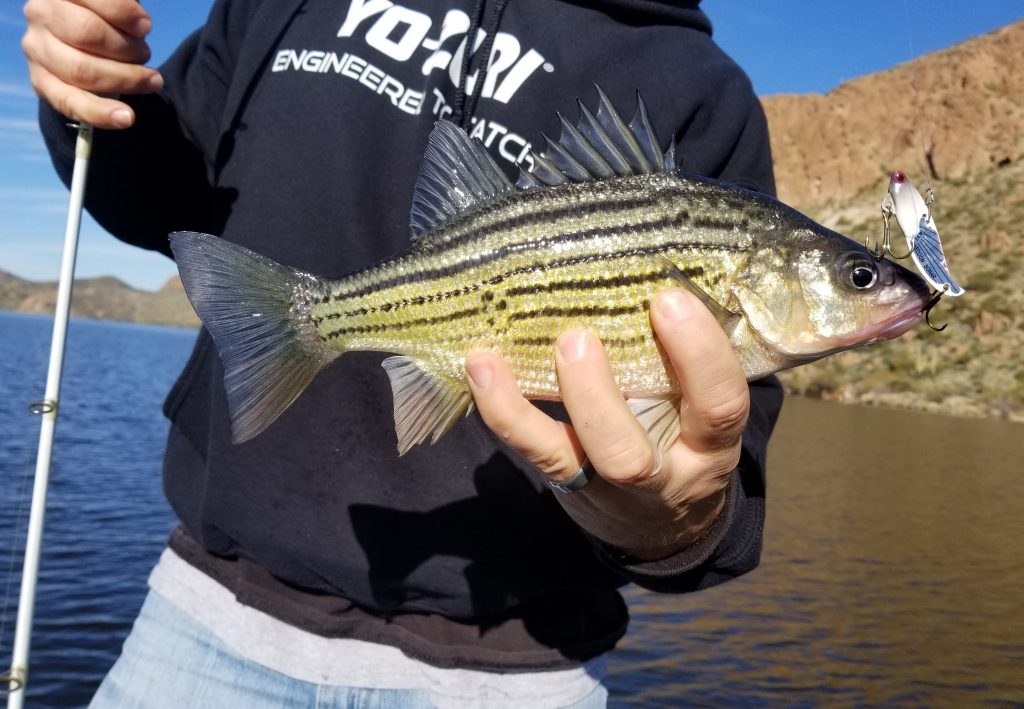Ron's Catch: Using Blade Baits in the Winter
There are many ways to target fish when the fish move offshore, but when they move deep and live bait is not an option, I am always looking for the best lure that imitates the closest thing to live bait. In the winter months when water is colder, the need to eat for predator fish slows way down and so does their activity. It’s not uncommon for bass or other species to move to depths of 40-80 feet or deeper at certain times of the year. They move to these depths because the water is more stable in temperature, has higher oxygen, and because that is where they will find their food source.
Most lakes around the country have some sort of baitfish, and for those of us who live in the Arizona desert, both threadfin and gizzard shad are the main food source. Because these top predators are not aggressive during the cold winter months, the size of your presentation often needs to be downsized. Going to a smaller presentation does not mean smaller fish, but a smaller profile is easier to eat and requires less energy to digest. There are plenty of lures today to choose from, but there are few lures that can reach the depths like a spoon and my other favorite, the “Blade Bait”. 
Blade Baits come in many sizes and weights. Much like a jigging or casting spoon, you need to experiment with the rate of fall and vary how you fish the lure to figure out what triggers the fish to bite.
The Blade Bait is always tied on, and one of my top 3, go-to lures in the winter months. The Blade Bait has a very erratic action when fished both vertical or casting and puts out a ton of vibration. This helps fish locate the lure in deep water where it is often dark or hard to see due to low light conditions.
My preferred method is to drop vertical whenever seeing fish on my electronics or feel there could be fish on or near the bottom. The key to most strikes is to let the lure hit the bottom keeping the rod tip close to the water with a tight line, then with a quick upward lift or flick of the wrist bringing the lure 6 inches to a foot off of the bottom. After this, slowly follow the line back to the bottom with your rod tip; then repeat.
Most strikes come very fast and, on the fall, which is why you want to follow your lure with the rod tip back down after the quick lift. If you just go through the motions by snapping your lure too fast and drop, you will not feel the strike of the lure. You need to have a quick reaction of setting the hook immediately upon feeling a “tick“on the line or you will miss the fish. Most Blade Bait style lures are made of metal, so it only takes a second for a bass or any other predator to realize this is not the real deal and toss the lure.
When you fire up a school or find an area of fish, you may also try casting the blade bait. Once again, after making a cast, allow the lure to hit the bottom. Once you see slack line, you will engage the reel and start with a slow pump and drop retrieve back to the boat allowing your lure to fall to the bottom each time. Remember to keep the line tight on this type of cast retrieve as well.
There are many shapes and sizes of blade baits such as a Cicada, Damiki Vortex, Molix Trago and even larger Blade Baits such as the Ledge Hog, but my personal favorite is the Heddon Sonar in ¼ ounce which is sold at Shopper Supply Stores. This has the right profile of about 1.5 to 2 inches in size which perfectly mimics the size of most shad. When this falls in front of their face, they either hit it right away or after a few rips become irritated enough to give a swipe at it. 
For tackle, I recommend a 7-foot medium spinning rod such as a Duckett Micro Magic with a fast to moderate action tip. This will allow you to set the hook with the smaller hooks that are usually stock on most blade baits or spoons without ripping them out of their mouth or tearing holes for better fish landing ratio. The reel I prefer is the Duckett Fishing Paradigm Spinning Reel Sri 2500 which is perfect in balance for any 6.6 to 7.4 spinning rod and holds enough line capacity for smooth long casts. It also has 10 ball bearings and carbon drag. If you’re going to use a large Blade Bait like the Ledge Hog mentioned that can weigh up to 2 ounces, then a heavier baitcasting application rod/reel will be recommended.
In addition to the tackle, I recommend the 20lb Seaguar Smackdown Braided Line that has very small diameter with no stretch. This allows you to feel the slightest of bites when fishing deep water where you have a lot of line out and will help you increase your hook ups because there is low- to no stretch in the line. The last 8-10 feet is 8-10 lbs. of Seaguar Invizx fluorocarbon line which will be your invisible leader that you will tie directly to your lure. I prefer the lighter tackle for several reasons. The lighter line allows for a more natural presentation because there is less drag from the heavier diameter lines used with a baitcasting set up. (Also available at Shoppers Supply). 
Over the years this has hands down produced more fish and generated more strikes that other fishing set ups. You can get away with spinning in most of our Arizona reservoirs because there is not much offshore structure for them to wrap up in or break off. It is common to land fish from 5 lbs. to 40 lbs. catfish on this kind of set up. Just remember to take your time and don’t horse your fish in from these depths. Fish over 28 feet deep need to come up slowly so they can regulate their swim bladder and adjust. A fish reeled up too fast can often die very quickly from what people commonly call “the bends.” Nitrogen gases expand in the fish swim bladder so fast that it crushes their internal organs causing certain damage or even death. If this happens, immediately take your hook out and send the fish back down in the water. If the fish floats or is unable to swim back down on its own, learn how to “Fizz a Bass” using a deflating needle. The insertion of the needle into the swim bladder will allow the pressure to escape deflating the swim bladder back to normal. You can learn how to properly fizz a fish by referring to this article or this video. Fish care is critical this time of year should you decide to try these techniques. 
Be sure to experiment with different manufacturers’ blade styles or colors to find the right lure. Sometimes it may take hours before dialing in the right presentation, but once you do, it’s almost like video game fishing if you have ability to watch this on your electronics. If you do not have electronics, use a good map and seek out points, ledges or areas you believe fish would migrate from the shallows and give it a try. My rule of thumb is, “If I don’t get a bite in 5 minutes, move!”
So next time you’re on the water, be sure to tie on a blade bait and always rotate it through your other presentations and areas. Soon, the Blade Bait be one of your go too lures for winter fishing.